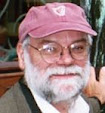The Mansfield House was, loosely defined, an intentional community. I guess "anarchists" (and many of these folks were anarchists, but not in the common sense of this term) don't form rigid intentional communities! What held this community together? Well, the community membership was dynamic, with people constantly moving in and out, but they did share many values: a dedication to nonviolence (in the Gandhian and Martin Luther King Jr. sense); opposition to the Vietnam War; and a dedication to living simply. I imagine many members felt marginalized in the normal American world, so there were psychological similarities in many of the Mansfield House's community members. Many came from a religious background. A number of the members were affiliated with the Friends, the Quakers (Dan Bromley, Caroline Bromley, possibly John Luginbill); others found the Mennonites to be friends in spirit; a number of people came out of the Catholic tradition (Peggy Scherer, Greg Haas, Kenny Przybylski, Jack Shereda, Anne Weinkam). One, Joan Levy, was a secular Jew. I didn't know if some others, like Bonnie Tompkins, were brought up in a religious tradition. Some of these people continued to practice their religion; others didn't.
Many people stayed in the Mansfield House for days, or weeks, or even longer, but probably wouldn't have been considered long-time members of the community. Others came over mostly during the day and just occasionally stayed there over night. Among these people would be Joel Stevens, Henry Scott, Mary Alice Shepherd, Chris Cotter, myself, Dick Crowley, Denny Ryan, Clare Weinkam, Paul Weinkam, and possibly Jim Tarbell. There were many others that don't immediately come to mind.
Subscribe to:
Post Comments (Atom)


No comments:
Post a Comment